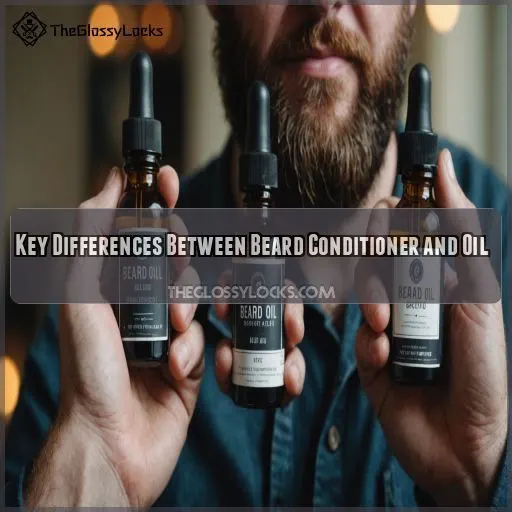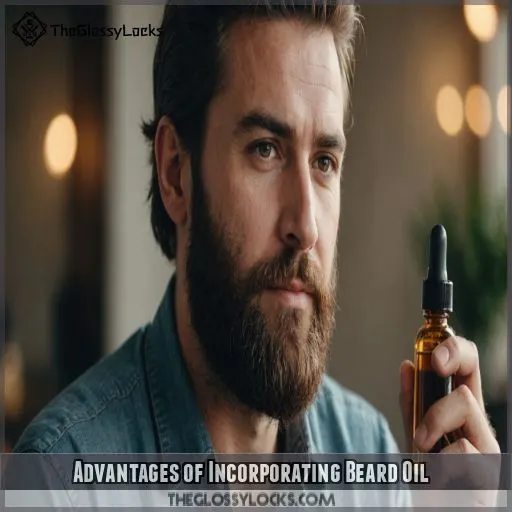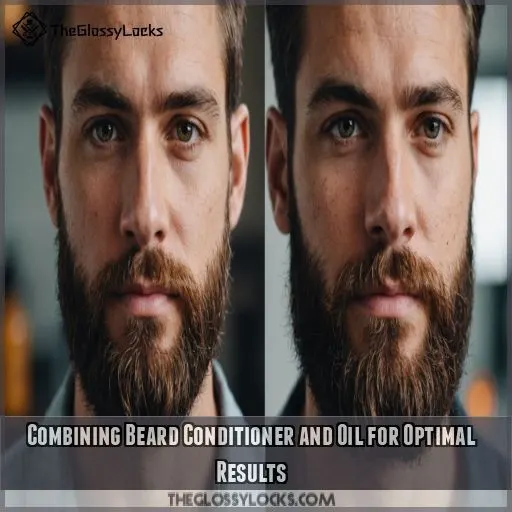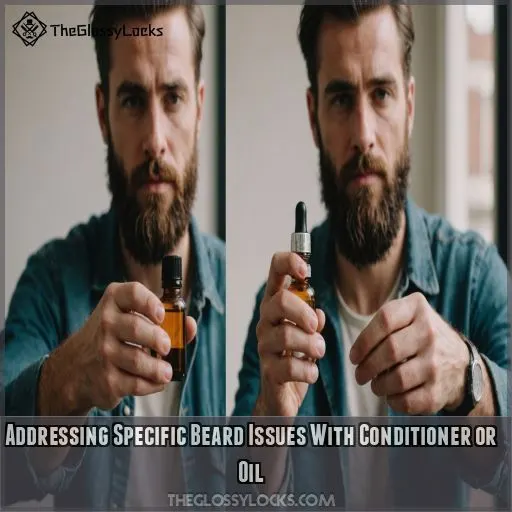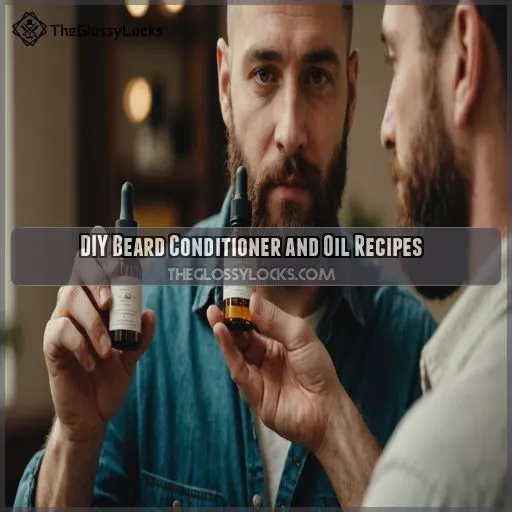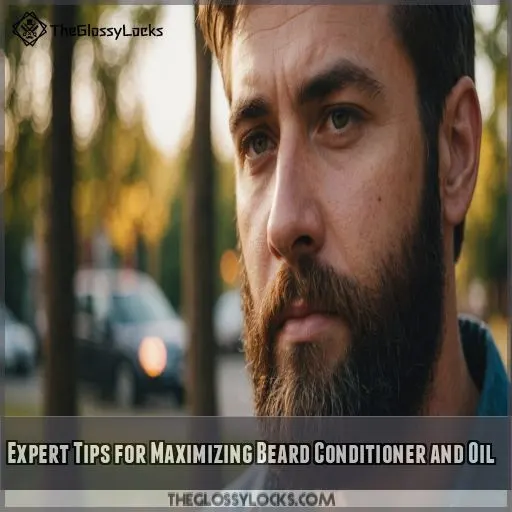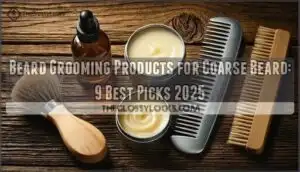This site is supported by our readers. We may earn a commission, at no cost to you, if you purchase through links.
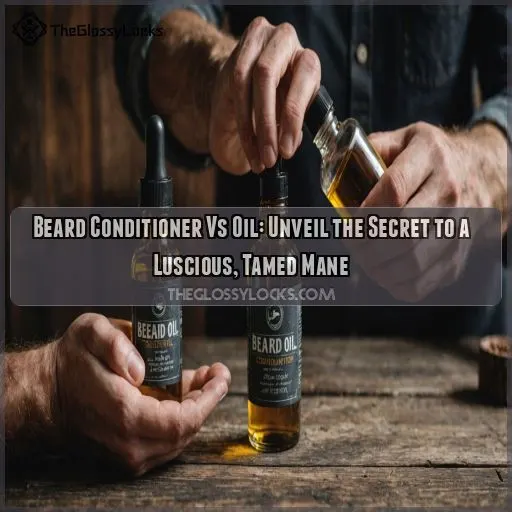 Ever wondered about the beard conditioner vs. oil showdown?
Ever wondered about the beard conditioner vs. oil showdown?
Here’s the scoop: they’re both facial hair heroes, but with different superpowers.
Beard conditioner is like a deep-hydrating spa treatment for your whiskers, taming wild hairs and softening your mane.
It’s perfect for those "my beard feels like sandpaper" days.
On the flip side, beard oil is your quick-fix glow-up, adding shine and nourishing your skin.
It’s ideal for daily use and can help promote growth.
Think of conditioner as your beard’s personal trainer and oil as its stylist.
The best part? You don’t have to choose – these dynamic duos work wonders together.
Ready to figure out the secrets of a truly luscious beard?
Table Of Contents
- Key Takeaways
- Key Differences Between Beard Conditioner and Oil
- Benefits of Using Beard Conditioner
- Advantages of Incorporating Beard Oil
- How to Choose Between Conditioner and Oil
- Combining Beard Conditioner and Oil for Optimal Results
- Addressing Specific Beard Issues With Conditioner or Oil
- DIY Beard Conditioner and Oil Recipes
- Expert Tips for Maximizing Beard Conditioner and Oil
- Frequently Asked Questions (FAQs)
- Which is better, beard oil or conditioner?
- Should you use beard oil and conditioner together?
- When should I use beard conditioner?
- Does conditioner make your beard softer?
- Can beard products affect facial hair color?
- How do beard conditioners and oils impact skin allergies?
- Are there age-specific recommendations for using these products?
- Can beard products influence the rate of facial hair growth?
- How do climate and seasons affect product choice?
- Conclusion
Key Takeaways
- Beard conditioner and oil are like Batman and Robin for your facial fuzz – they’ve got different superpowers, but together they’re unstoppable. Conditioner is your deep-hydrating spa treatment, while oil is your quick-fix stylist for that daily glow-up.
- Timing is everything in the beard game. Slap on that conditioner during your shower for a deep cleanse, then follow up with a few drops of oil post-rinse. It’s like giving your beard a one-two punch of moisture and shine.
- Your beard’s needs change with the seasons, just like your wardrobe. In winter, cozy up to more conditioner to fight the dreaded beard-icles. Come summer, lighten up on the oil to avoid looking like you’ve deep-fried your chin.
- DIY beard potions are easier than brewing a cup of joe. Whip up your own conditioner or oil with kitchen staples like coconut oil and essential oils. It’s like being a mad scientist, but for your face!
Key Differences Between Beard Conditioner and Oil
You’ve got your beard game on point, but you’re caught between beard conditioner and oil. Let’s clear up the confusion and help you choose the right product for your facial fuzz, so you can rock that magnificent mane with confidence.
Composition and Ingredients
Beard conditioner and oil are like night and day in your grooming arsenal. Here’s what sets them apart:
- Conditioner: Thicker, with butters and humectants
- Oil: Lighter, featuring essential and carrier oils
- Conditioner: Often water-based
-
Oil: Typically anhydrous (water-free)
These differences make each product unique in taming your mane.
Application Methods and Frequency
Now, let’s talk application. You’ll use beard oil daily on a dry beard, but conditioner’s your shower buddy. Oil needs just a few drops, while conditioner requires a dollop. Remember, consistency’s key! Apply oil post-shower for pre-styling, and conditioner during your rinse for ultimate hydration.
Absorption and Lasting Effects
Want to keep your beard game strong? Absorption and lasting effects are key. Here’s the scoop on beard conditioner vs. oil:
- Oil seeps in quickly, giving your beard an instant glow-up
- Conditioner takes its sweet time, providing deep hydration
- Both leave your beard feeling smoother than a jazz saxophone solo
Targeted Benefits for Beard and Skin
Your beard’s crying out for help? Listen up! Conditioner’s your go-to for deep hydration and taming wild hairs, while oil’s the MVP for shine and skin nourishment. Together, they’re the dynamic duo that’ll kick beard dandruff and itchiness to the curb. Hello, healthy beard!
Benefits of Using Beard Conditioner
You’re about to discover why beard conditioner might be your facial hair’s new best friend. From taming unruly whiskers to giving your beard a silky-smooth feel, this grooming game-changer packs a powerful punch in the battle against dry, itchy, and unmanageable beards.
Intense Hydration Properties
Struggling with a thirsty beard? Beard conditioner’s your hydration hero! It’s like giving your facial fuzz a tall drink of water. Packed with moisturizing powerhouses like argan oil and shea butter, it’ll quench even the coarsest of beards. Say goodbye to dry skin woes, especially during those harsh winter months. Your beard will thank you for this deep conditioning treat!
Beard Softening Effects
Ever touched a cloud? That’s how your beard will feel with the right conditioner. It’s like giving your facial fuzz a spa day! Packed with cocoa seed butter and other soft beard ingredients, a good leave-in beard conditioner works wonders. You’ll say goodbye to that prickly, wire-brush feeling and hello to a mane that’s smoother than a sweet-talkin’ salesman.
Styling And Manageability
Ever felt like your beard has a mind of its own? Beard conditioner’s your ticket to taming that wild mane. It’ll make styling a breeze, giving you:
- Smoother, more pliable hair
- Enhanced grip for styling tools
- Longer-lasting hold for your chosen look
Whether you’re rocking a full lumberjack or a neat goatee, conditioner’s your secret weapon for a beard that behaves. Trust me, your comb will thank you!
Advantages of Incorporating Beard Oil
Beard oil is like a superhero cape for your beard, swooping in to save the day for curly beards.
.
It transforms your beard from a scruffy mess to a silky-smooth masterpiece.
Beard oil adds a healthy shine, promotes growth, and keeps your skin happy.
The secret? Nourishing ingredients like jojoba and argan oil.
Plus, you’ll smell like a million bucks!
Who knew a few drops could pack such a punch?
Your beard will thank you!
How to Choose Between Conditioner and Oil
Choosing between beard conditioner and oil can be a game-changer for your facial hair game. Let’s explore the factors that’ll help you pick the perfect product for your unique beard and lifestyle, ensuring you’ll be stroking a soft, well-groomed mane in no time.
Considering Beard Length and Texture
Depending on your beard’s length and texture, you’ve got options. Short beards? A lightweight oil might do the trick. Rocking a longer mane? Conditioner’s your best friend. Got coarse hair that’s harder to tame? Combine both for a silky-smooth finish.
Skin Type and Sensitivity
After considering length and texture, it’s time to think about your skin. Your skin type really matters when choosing between conditioner and oil. Here’s what to keep in mind:
- Oily skin: Light beard oil
- Dry skin: Rich conditioner
- Sensitive skin: Fragrance-free options
- Combination skin: Rotate products
Climate and Environmental Factors
Don’t let the weather rain on your beard parade! Climate’s a game-changer for your facial fuzz. In dry air, beard oil‘s your BFF, while humid days call for conditioner‘s helping hand. Seasonal shifts? Mix it up! Your beard’s happiness depends on adapting to Mother Nature’s moods.
Personal Grooming Routine and Preferences
Your beard groove matters! If you’re a wash-and-go guy, beard oil’s your wingman. Love pampering? Conditioner’s your jam. Short on time? Oil’s quick fix. Fancy experimenting? Mix it up! Your routine should fit like a glove, not pinch like tight jeans.
Combining Beard Conditioner and Oil for Optimal Results
You’ve mastered the basics of beard care, but now it’s time to level up your grooming game. By combining beard conditioner and oil, you’ll discover the secret to achieving a perfectly moisturized, manageable, and downright majestic facial mane.
Layering Techniques
Ready to take your beard game to the next level? Let’s talk layering! Combining beard conditioner and oil isn’t rocket science, but it’s an art. Start with a clean slate, then apply your conditioner. Once that’s soaked in, add a few drops of oil. This dynamic duo will have your beard feeling softer than a kitten’s belly in no time!
Timing and Order of Application
Now that you’ve mastered layering, let’s talk timing. The order you do things in your beard care routine matters. Here’s a quick guide to help you nail the sequence:
- Wash with beard shampoo
- Apply leave-in conditioner
- Let it dry slightly
- Finish with a few drops of beard oil
Balancing Moisture and Hold
Now that you’ve got the timing down, let’s talk about balancing moisture and hold.
It’s like conducting an orchestra for your beard!
Use your conditioner as the baseline, providing deep hydration.
Then, layer on beard oil for extra nourishment and shine.
Finally, if you need more control, a dab of balm will keep those whiskers in line.
Experiment to find your perfect harmony!
Addressing Specific Beard Issues With Conditioner or Oil
Are you grappling with pesky beard problems that just won’t quit? Whether it’s dryness, frizz, or patchy growth, we’ll help you find solutions for your specific facial hair woes with the lowdown on how beard conditioner and oil can tackle them.
Tackling Dryness and Itchiness
Now, let’s tackle the bane of beardsmen everywhere: dryness and itchiness. These pesky problems can turn your mane from magnificent to miserable. Here’s how to send them packing:
- Hydrate like crazy
- Exfoliate gently
- Lock in moisture with oil or conditioner
Managing Frizz and Flyaways
Tame those wild whiskers! Beard oil and conditioner are your secret weapons against frizz and flyaways. Apply a dab of balm or oil, then use a boar bristle brush to smooth things out. You’ll go from scruffy to suave in no time!
Promoting Growth and Fullness
Craving a fuller beard? You’re not alone! While genetics play a role, you can boost growth with the right products. Conditioner and oil work wonders, nourishing your facial hair from root to tip. Here’s how to maximize your mane’s potential:
- Feed your follicles: A balanced diet rich in vitamins A, C, and E promotes healthy growth.
- Massage matters: Gentle circular motions stimulate blood flow and distribute natural oils.
- Stress less: High cortisol levels can hinder hair growth, so find ways to relax and unwind.
- Product power: Alternate between conditioner and oil to keep your beard hydrated and strong.
Combating Beard Dandruff
Battling beard dandruff? Don’t fret! Both conditioner and oil can be your secret weapons. Here’s a quick guide to banish those flakes:
| Product | Benefits | Usage Tips |
|---|---|---|
| Conditioner | Moisturizes scalp | Massage thoroughly |
| Oil | Nourishes follicles | Apply sparingly |
| Both | Reduces irritation | Use consistently |
| Natural remedies | Soothes skin | Try tea tree oil |
DIY Beard Conditioner and Oil Recipes
Ever wondered how to whip up your own beard-taming concoctions? You’re in luck – we’re about to share some easy DIY recipes for beard conditioners and oils that’ll have your facial hair looking and feeling its best in no time.
Natural Ingredients for Homemade Solutions
Ready to concoct your own beard elixir? It’s easier than you think! Whip up a natural remedy that’ll have your whiskers singing. Here’s a quick list of kitchen staples to get you started:
- Coconut oil: Nature’s moisturizer
- Jojoba oil: Your beard’s new best friend
- Shea butter: Softness in a simple form
- Essential oils: For that manly aroma
Mix and match, and you’ll be stroking a silky mane in no time!
Customizing Formulas for Personal Needs
Now that you’ve got the basics down, let’s tailor your beard care to your unique needs. Customizing your DIY blends is like creating your signature scent – it’s all about you! Check out this handy table for inspiration:
| Concern | Essential Oil Blend |
|---|---|
| Dry skin | Lavender + Jojoba |
| Itchiness | Tea Tree + Eucalyptus |
| Growth | Cedarwood + Rosemary |
| Sensitive skin | Chamomile + Almond |
Mix and match to find your perfect formula!
Storage and Shelf Life Considerations
Now that you’ve whipped up your custom beard elixirs, let’s talk storage. Keeping your DIY concoctions fresh is key to maintaining their potency. Here’s a quick hit list for preserving your beard-beautifying brews:
- Choose dark glass bottles to shield from light
- Store in a cool, dry place (no bathroom steam parties!)
- Label with creation dates and ingredients
- Use within 3-6 months for peak performance
- Refrigerate oil-based recipes to extend shelf life
Expert Tips for Maximizing Beard Conditioner and Oil
You’ve got your beard conditioner and oil, but are you using them to their full potential? Let’s explore some expert tips that’ll help you maximize these grooming essentials and take your beard game to the next level.
Proper Application Techniques
| Product | Application Technique | Key Tip |
|---|---|---|
| Oil | Warm in palms, massage in | Start at roots |
| Conditioner | Apply evenly, comb through | Focus on ends |
| Balm | Melt between fingers, work in | Style as desired |
| Butter | Scoop small amount, distribute | Great for dry beards |
| Serum | Use dropper, pat gently | Perfect for precision |
Incorporating Into Daily Grooming Routine
Now that you’ve mastered the art of application, let’s weave these products into your daily routine. In the morning, pair your beard oil with your skincare regimen. It’s like giving your facial fuzz a power breakfast! For your evening wind-down, treat your beard to some conditioner love. Don’t forget to pack travel-sized versions for on-the-go grooming!
Adjusting Usage Based on Seasonal Changes
Just like your wardrobe, your beard care routine needs seasonal tweaks. In winter, amp up the conditioner to combat dryness. Summer calls for lighter oils to prevent greasiness. Living in a dry climate? Double down on moisture. Humid area? Go easy on the oil. Remember, your beard’s a living thing – it’ll thank you for adjusting to its ever-changing needs.
Frequently Asked Questions (FAQs)
Which is better, beard oil or conditioner?
You’ll benefit from both! Beard oil moisturizes daily, while conditioner deep-cleanses weekly. They’re a dynamic duo for your facial fuzz. Mix and match to find your perfect beard care routine. It’s like a spa day for your chin!
Should you use beard oil and conditioner together?
Like peanut butter and jelly, beard oil and conditioner are a match made in facial hair heaven. You’ll want to use both for the best results. Conditioner hydrates deeply, while oil seals in moisture and adds shine. It’s a dynamic duo!
When should I use beard conditioner?
You’ll want to use beard conditioner when you’re washing your beard. Apply it in the shower, leave it on for a few minutes, then rinse. It’s your secret weapon for taming that wild facial mane!
Does conditioner make your beard softer?
You’ve heard the buzz, but does it hold up? Yes, conditioner does make your beard softer. It’s like giving your facial hair a spa day, leaving it smooth and manageable. You’ll be stroking your silky beard in no time!
Can beard products affect facial hair color?
While beard products don’t typically change your facial hair color, some can enhance its natural shade. You might notice a subtle darkening or added shine, but don’t worry – you won’t suddenly sport a rainbow beard!
How do beard conditioners and oils impact skin allergies?
Ah, the joys of beard care! You’re not just pampering your facial fuzz; you’re playing Russian roulette with your skin. Oils and conditioners can trigger allergies, so patch test first. It’s better to itch and learn than scratch and burn!
Are there age-specific recommendations for using these products?
You’re never too old for a great beard! Start using oils in your 20s to prevent itchiness. As you age, add conditioners to combat dryness. Remember, it’s not about years—it’s about what your beard needs.
Can beard products influence the rate of facial hair growth?
While beard products can’t magically speed up hair growth, they’ll nourish your skin and follicles. You’ll create a healthier environment for growth, potentially making your beard appear fuller and grow more evenly. Keep at it, bearded warrior!
How do climate and seasons affect product choice?
You’ll want to switch up your beard game with the seasons. Humid summers? Opt for lighter oils. Dry winters? Go for richer conditioners. Your beard’s like a weathervane – adjust your products to keep it looking sharp!
Conclusion
You’ve survived the epic "beard conditioner vs oil" battle royale!
But here’s the plot twist: they’re not mortal enemies after all.
Think of them as your facial hair‘s dynamic duo, tag-teaming to give you that coveted luscious mane.
Experiment with both, find your perfect balance, and watch your beard transform from scruffy to suave.
So go forth, brave beardsman, armed with your newfound knowledge.
Your journey to beard nirvana awaits – may the follicles be ever in your favor!

